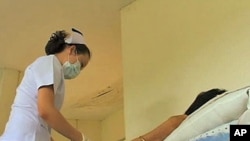A recent U.N. report says global HIV rates are going down - but not in every region of the world. In Eastern Europe and Central Asia the number of HIV-positive people has nearly tripled in the past decade.
Vladimir Osin is a 30-year-old social worker who lives in St. Petersburg, Russia. He used to inject drugs and, like a fast growing number of Russians, is now HIV-positive.
"I was 15-years old when I start to smoke drugs," he explained, "and then in two or three years I start to use injection drugs and when I was using drugs I need to share needles with my friends."
He said he knew little about the risks he was taking. When he was 20 years old, after three years injecting drugs, he went into a rehabilitation program. Now, he says, anti-retroviral therapy is helping him live a healthy life.
"I do not know, I think I am a lucky guy. I am a lucky guy because I have HIV and Hepatitis C, but I have no problems with my health and everything is okay," he said.
But Osin says for people who are HIV-positive and still using drugs, the health system in Russia is not so effective. He says many doctors do not believe that addicts will take their medication correctly and so do not help them to get the right medication.
Denis Broun, Regional Director of UNAIDS for Europe and Central Asia, says in that region less than 20 percent of people who need treatment for HIV infection receive it. That compares with 40 percent of people in Africa.
Earlier this month, UNAIDS published its annual report on the global state of the HIV/AIDS epidemic.
The report found that in the 10 years between 1999 and 2009 the global incidence of HIV infection fell by almost 20 percent.
But it found a different story in Eastern Europe and Central Asia.
"This region is the only region in the world where the number of cases continues to increase. Most of the transmission has been through drug users who are injecting drugs and there is a real problem with heroine use, notably in Russia and Central Asia," Broun said.
Heroine, he says, pours into the region from nearby countries.
"There are many drug trafficking routes coming to Eastern Europe, mostly coming from Afghanistan but also through Iran, Turkey, the Caucasus," Broun said. "It comes through the countries from Central Asia and is commercialized westward through Russia."
According to the U.N. report, the Russian Federation and Ukraine account for nearly 90 percent of newly reported infections in the region.
It says that increase is largely because prevention measures for most at risk populations are not working.
Rick Lines is executive director of the International Harm Reduction Association.
"The Russian government refuses pointblank to support needle and syringe programs and to support the availability of methadone," he said, "both of which are very strongly evidence based and scientifically based interventions to prevent the spread of HIV and improve the health of people who use injecting drugs."
He says programs carried out elsewhere in the world show helping people use drugs in a safe environment does not encourage drug use.
"The availability of sterile syringes in no way increases the number of people injecting, it no way increases the amount of illegal drugs being used, but what it does do very effectively is reduce the need of people to share syringes amongst their peers and their friends with whom they inject," Lines said. "And therefore it becomes a very effective intervention to actually stop the transmission of HIV."
The U.N. report published earlier this month says about one-percent of Russians, or 1.4 million people, are HIV-positive. It says globally more than 30 million people have HIV, the virus that causes AIDS.
HIV Infections Triple in Eastern Europe




